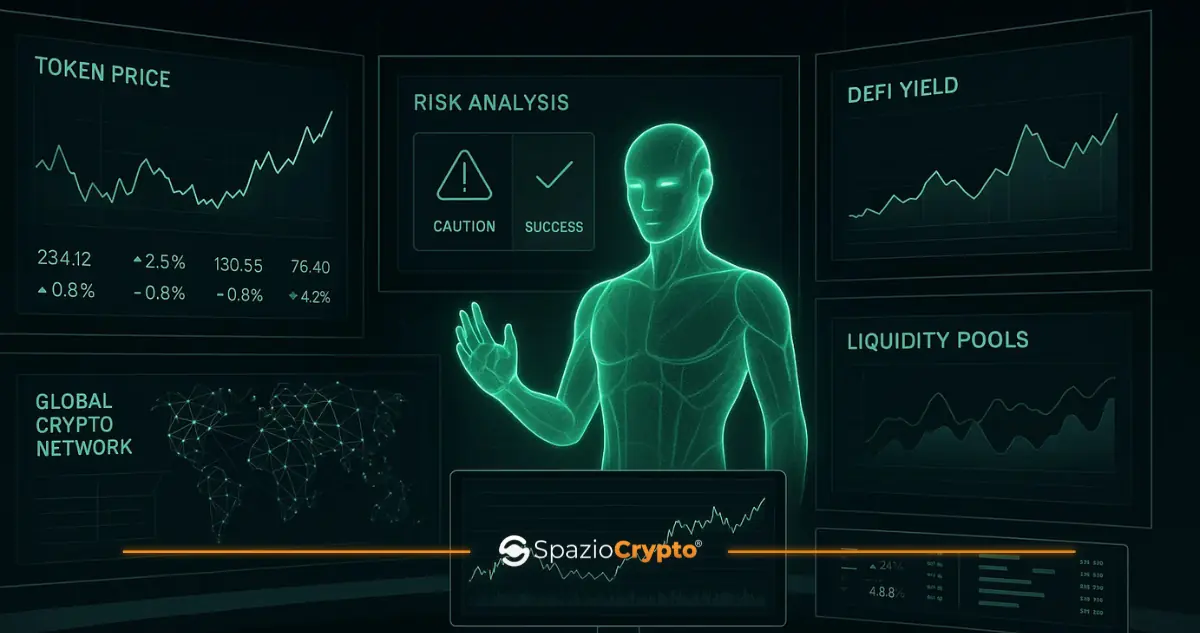In recent years, the world of finance has witnessed an incredible evolution thanks to the advent of Decentralised Finance (DeFi). In this Spaziocrypto Web3 guide, we will explore the differences and similarities between traditional finance and DeFi, and attempt to outline future prospects for integration between the two. While traditional finance has long been the mainstay of our financial institutions, DeFi offers an entirely new paradigm based on emerging technologies such as blockchain and smart contracts. Through an in-depth analysis, we will understand the challenges, opportunities and implications of these two financial systems, asking whether the future of finance lies in the harmonious integration of both worlds or in a radical transformation towards a new decentralised financial system.
Fundamental Concepts of Traditional Finance
Traditional finance is an established system of capital and investment management that has evolved over centuries. It is based on a set of fundamental principles and concepts that provide the basis for financial decisions and instruments used in traditional financial markets. Some of the main concepts of traditional finance are described below.
Financial Markets
The traditional financial markets are places where investors and traders buy and sell financial instruments such as stocks, bonds, and derivatives. These markets can be categorised into primary markets, where new securities are issued, and secondary markets, where trading in existing securities takes place.
Stocks and Bonds
Stocks represent ownership of a part of a company and provide holders with rights such as profit sharing and voting rights in corporate decisions. Bonds, on the other hand, are debt securities issued by governmental entities or corporations and represent a commitment to pay periodic interest and repay principal to the investor.
Portfolio and Diversification
Diversification is a key concept in building a financial portfolio. Investing in a variety of assets reduces overall portfolio risk, as investments react differently to the same market conditions. A well-diversified portfolio can help mitigate risk without over-sacrificing potential returns.
Financial intermediation
Financial institutions play a key role in intermediating between those who save and those who seek finance. Banks, for example, collect deposits from savers and grant loans to individuals and businesses. This intermediation process facilitates the efficient allocation of capital in the economy.
Monetary Policy and Regulation
Monetary policies, determined by monetary authorities such as central banks, influence lending conditions and the availability of liquidity in the economy. Financial regulation establishes the rules and requirements that financial institutions must comply with to ensure the stability and transparency of the financial system.
Valuation and Financial Analysis
Financial analysts assess investment opportunities using a variety of analytical techniques and models. This includes fundamental analysis, which evaluates the fundamentals of a company, such as its profits and cash flows, and technical analysis, which relies on past price movements to predict future price movements.
Derivative Instruments
Derivatives are financial instruments whose value is derived from the performance of an underlying asset, such as stocks, bonds, or commodities. These instruments include futures, options, and swaps and are used for hedging, speculation, and arbitrage purposes.
The Emergence of Decentralised Finance (DeFi)
After analysing the characteristics of traditional finance, let us move on to understand how DeFi works. Decentralised Finance (DeFi) represents one of the most revolutionary innovations in finance in recent years. Rather than relying on centralised financial institutions such as banks or brokers, DeFi uses blockchain technology and smart contracts to create an open, transparent and autonomous financial ecosystem.
DeFi's origin
The emergence of DeFi can be traced back to early 2010, with the development of Bitcoin as the first decentralised cryptocurrency. However, it was only with the introduction of Ethereum in 2015 that DeFi began to take shape. Ethereum introduced smart contracts, which are computer codes executed automatically when certain conditions are met, enabling the creation of decentralised financial applications.
Over the next few years, numerous DeFi platforms and protocols emerged, offering a wide range of financial services, including loans and lending, decentralised exchanges (DEX), derivatives, and even wealth management. The rapid development of DeFi has been fuelled by technological innovation, growing investor interest, and the search for alternatives to traditional finance.
Fundamental Principles of DeFi
DeFi is based on a few key principles that define its nature and operation:
- Decentralisation: DeFi eliminates the need for centralised intermediaries, allowing users to interact directly with each other through decentralised protocols. This reduces the risk of censorship, manipulation and fraudulent intermediation.
- Transparency: All transactions and smart contracts are permanently recorded on the blockchain, making the data accessible to all users in a transparent and verifiable manner. This transparency increases trust and security in the DeFi ecosystem.
- Autonomy: Users retain direct control of their funds and financial transactions, without having to rely on third parties for safekeeping or management. This offers greater freedom and autonomy to users than traditional finance.
- Interoperability: DeFi ecosystems are beginning to be designed to be interoperable, allowing users to use different protocols and applications seamlessly. This fosters innovation and the evolution of the DeFi ecosystem as a whole.
Impact of DeFi
The advent of DeFi has had a significant impact on the global financial landscape, bringing a number of benefits and challenges:
- Financial Inclusion: DeFi provides access to financial services to millions of people who would otherwise be excluded from the traditional financial system, especially in regions with underdeveloped financial infrastructure.
- Efficiency: The Decentralised Web3 protocols automate many of the financial transactions, reducing transaction costs and times and increasing the overall efficiency of the financial system.
- Regulatory Challenges: The decentralised and global aspect of cryptocurrencies presents unique regulatory challenges, as financial regulations vary from jurisdiction to jurisdiction and may not be suited to the decentralised nature of DeFi ecosystems.
- Security: Despite the inherent security of blockchain, smart contracts and decentralised platforms are still vulnerable to bugs and cyber attacks. Security therefore remains a critical challenge for the development and large-scale adoption of DeFi.
Although the emergence of Decentralised Finance represents a significant breakthrough in the financial sector, promoting innovation, inclusion and democratisation of access to financial services, a number of challenges and obstacles remain to be addressed before DeFi can fully realise its potential as an alternative to traditional finance.
Key Differences Between Traditional Finance and DeFi
Comparison between traditional finance and decentralised finance (DeFi) reveals a number of significant differences that go beyond simple structure and mode of operation. In this chapter, we will examine in detail the key distinctions between the two financial systems.
- Structure and Governance: Traditional finance is characterised by a centralised structure with dominant financial institutions and central regulators. In contrast, DeFi is based on cryptocurrencies and a decentralised structure with decisions made by the community and protocols governed by holders.
- Financial Accessibility and Inclusion: While traditional finance often excludes unbanked individuals or those from underdeveloped regions, DeFi offers open and global access to financial services.
- Transparency and Security: DeFi boasts greater transparency due to the public nature of the blockchain, allowing users to verify transactions and contracts independently. However, this advantage also brings challenges in terms of cybersecurity and vulnerability to attacks.
- Costs and Efficiency:
- DeFi promises reduced costs and greater efficiency than traditional finance by eliminating intermediaries and manual processes. However, the volatility of decentralised markets and transaction fees may affect the actual cost-effectiveness of DeFi services.
- Regulation and Compliance: While traditional finance is subject to strict regulations to ensure stability and investor protection, DeFi operates largely without regulated supervision.
A Future of Integration Between Traditional and Decentralised Finance
Comparing traditional and decentralised finance (DeFi) reveals a complex and evolving landscape, with challenges, opportunities and implications that deserve careful consideration. We have examined the structural, governance, accessibility and transparency differences between traditional finance and DeFi. However, we have also identified points of convergence, such as the goal of providing accessible and efficient financial services.
- Challenges and Risks: DeFi faces significant challenges related to cybersecurity, market volatility, lack of regulation and vulnerability of smart contracts. It is critical to address these challenges to ensure user trust and system stability.
- Opportunities and Benefits:
- At the same time, DeFi offers unique opportunities such as financial inclusion, reduced costs and global access to
- crypto wallets
- . These advantages could revolutionise the way people access and manage their money around the world.
- Future Integration: The future of finance could be characterised by a smooth integration between traditional finance and DeFi. As DeFi continues to grow and mature, we may see greater collaboration and synergy between the two financial worlds.
- Continued Exploration and Monitoring: It is important to continue to explore and closely monitor the development of DeFi and its impact on global finance. Continued research and innovation will be crucial to drive the evolution of both financial systems.
In conclusion, traditional finance and DeFi represent two complementary approaches that can co-exist in the modern financial landscape. At Spaziocrypto, we are convinced that the challenge lies in balancing the opportunities offered by DeFi with the need to address the associated challenges and risks. With a balanced vision and responsible leadership, we can shape a more inclusive, efficient and resilient financial future for all.








